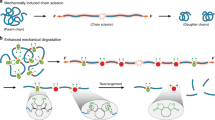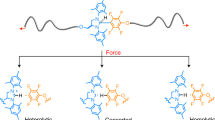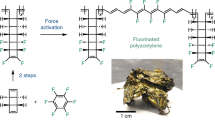Abstract
Force can induce remarkable non-destructive transformations along a polymer, but we have a limited understanding of the energy transduction and product distribution in tandem mechanochemical reactions. Ladderanes consist of multiple fused cyclobutane rings and have recently been used as monomeric motifs to develop polymers that drastically change their properties in response to force. Here we show that [4]-ladderane always exhibits ‘all-or-none’ cascade mechanoactivations and the same stereochemical distribution of the generated dienes under various conditions and within different polymer backbones. Transition state theory fails to capture the reaction kinetics and explain the observed stereochemical distributions. Ab initio steered molecular dynamics reveals unique non-equilibrium dynamic effects: energy transduction from the first cycloreversion substantially accelerates the second cycloreversion, and bifurcation on the force-modified potential energy surface leads to the product distributions. Our findings illustrate the rich chemistry in closely coupled multi-mechanophores and an exciting potential for effective energy transduction in tandem mechanochemical reactions.
This is a preview of subscription content, access via your institution
Access options
Access Nature and 54 other Nature Portfolio journals
Get Nature+, our best-value online-access subscription
$29.99 / 30 days
cancel any time
Subscribe to this journal
Receive 12 print issues and online access
$259.00 per year
only $21.58 per issue
Buy this article
- Purchase on Springer Link
- Instant access to full article PDF
Prices may be subject to local taxes which are calculated during checkout






Similar content being viewed by others
Data availability
Optimized geometries for the structures discussed in the text are available in the supplementary files in the online version of the paper. The experimental and simulation data that support the findings of this study are available from the authors upon request.
Code availability
The program TeraChem (v1.92), used for steered ab initio molecular dynamics calculations and reaction path optimization, is available from PetaChem, LLC (http://www.petachem.com/products.html). The scripts used to analyse the trajectories are available upon request from T.J.M.
References
Li, J., Nagamani, C. & Moore, J. S. Polymer mechanochemistry: from destructive to productive. Acc. Chem. Res. 50, 2181–2090 (2015).
Hickenboth, C. R. et al. Biasing reaction pathways with mechanical force. Nature 446, 423–427 (2007).
Lenhardt, J. M. et al. Trapping a diradical transition state by mechanochemical polymer extension. Science 329, 1057–1060 (2010).
Piermattei, A., Karthikeyan, S. & Sijbesma, R. P. Activating catalysts with mechanical force. Nat. Chem. 1, 133–137 (2009).
Davis, D. A. et al. Force-induced activation of covalent bonds in mechanoresponsive polymeric materials. Nature 459, 68–72 (2009).
Robb, M. J. et al. Regioisomer-specific mechanochromism of naphthopyran in polymeric materials. J. Am. Chem. Soc. 138, 12328–12331 (2016).
Chen, Y. et al. Mechanically induced chemiluminescence from polymers incorporating a 1,2-dioxetane unit in the main chain. Nat. Chem. 4, 559–562 (2012).
Ducrot, E., Chen, Y., Bulters, M., Sijbesma, R. P. & Creton, C. Toughening elastomers with sacrificial bonds and watching them break. Science 344, 186–189 (2014).
Larsen, M. B. & Boydston, A. J. ‘Flex-activated’ mechanophores: using polymer mechanochemistry to direct bond bending activation. J. Am. Chem. Soc. 135, 8189–8192 (2013).
Gossweiler, G. R. et al. Mechanochemical activation of covalent bonds in polymers with full and repeatable macroscopic shape recovery. ACS Macro Lett. 3, 216–219 (2014).
Nagamani, C., Liu, H. & Moore, J. S. Mechanogeneration of acid from oxime sulfonates. J. Am. Chem. Soc. 138, 2540–2543 (2016).
Verstraeten, F., Gostl, R. & Sijbesma, R. P. Stress-induced colouration and crosslinking of polymeric materials by mechanochemical formation of triphenylimidazolyl radicals. Chem. Commun. 52, 8608–8611 (2016).
Imato, K. et al. Repeatable mechanochemical activation of dynamic covalent bonds in thermoplastic elastomers. Chem. Commun. 52, 10482–10485 (2016).
Klukovich, H. M., Kouznetsova, T. B., Kean, Z. S., Lenhardt, J. M. & Craig, S. L. A backbone lever-arm effect enhances polymer mechanochemistry. Nat. Chem. 5, 110–114 (2013).
Ong, M. T., Leiding, J., Tao, H., Virshup, A. M. & Martínez, T. J. First principles dynamics and minimum energy pathways for mechanochemical ring opening of cyclobutene. J. Am. Chem. Soc. 131, 6377–6379 (2009).
Chen, Z. et al. Mechanochemical unzipping of insulating polyladderene to semiconducting polyacetylene. Science 357, 475–479 (2017).
Hermes, M. & Boulatov, R. The entropic and enthalpic contributions to force-dependent dissociation kinetics of the pyrophosphate bond. J. Am. Chem. Soc. 133, 20044–20047 (2011).
Akbulatov, S. et al. Experimentally realized mechanochemistry distinct from force-accelerated scission of loaded bonds. Science 357, 299–303 (2017).
Kryger, M. J. et al. Masked cyanoacrylates unveiled by mechanical force. J. Am. Chem. Soc. 132, 4558–4559 (2010).
Kryger, M. J., Munaretto, A. M. & Moore, J. S. Structure–mechanochemical activity relationships for cyclobutane mechanophores. J. Am. Chem. Soc. 133, 18992–18998 (2011).
Klukovich, H. M., Kean, Z. S., Iacono, S. T. & Craig, S. L. Mechanically induced scission and subsequent thermal remending of perfluorocyclobutane polymers. J. Am. Chem. Soc. 133, 17882–17888 (2011).
Kean, Z. S., Black Ramirez, A. L., Yan, Y. & Craig, S. L. Bicyclo[3.2.0]heptane mechanophores for the non-scissile and photochemically reversible generation of reactive bis-enones. J. Am. Chem. Soc. 134, 12939–12942 (2012).
Kean, Z. S., Niu, Z., Hewage, G. B., Rheingold, A. L. & Craig, S. L. Stress-responsive polymers containing cyclobutane core mechanophores: reactivity and mechanistic insights. J. Am. Chem. Soc. 135, 13598–13604 (2013).
Robb, M. J. & Moore, J. S. A retro-Staudinger cycloaddition: mechanochemical cycloelimination of a beta-lactam mechanophore. J. Am. Chem. Soc. 137, 10946–10949 (2015).
Wang, J., Kouznetsova, T. B., Boulatov, R. & Craig, S. L. Mechanical gating of a mechanochemical reaction cascade. Nat. Commun. 7, 13433 (2016).
Bowser, B. H. & Craig, S. L. Empowering mechanochemistry with multi-mechanophore polymer architectures. Polym. Chem. 9, 3583–3593 (2018).
Nayler, P. & Whiting, M. C. Researches on polyenes. Part III. The synthesis and light absorption of dimethylpolyenes. J. Chem. Soc. 3037–3047 (1955).
Thompson, L. H. & Doraiswamy, L. K. Sonochemistry: science and engineering. Ind. Eng. Chem. Res. 38, 1215–1249 (1999).
El-Agamey, A. et al. Carotenoid radical chemistry and antioxidant/pro-oxidant properties. Arch. Biochem. Biophys. 430, 37–48 (2004).
Schügerl, F. B. & Kuzmany, H. Optical modes of trans‐polyacetylene. J. Chem. Phys. 74, 953–958 (1981).
Knoll, K. & Schrock, R. R. Preparation of tert-butyl-capped polyenes containing up to 15 double bonds. J. Am. Chem. Soc. 111, 7989–8004 (1989).
Ribas-Arino, J., Shiga, M. & Marx, D. Mechanochemical transduction of externally applied forces to mechanophores. J. Am. Chem. Soc. 132, 10609–10614 (2010).
Carpenter, B. K. Nonstatistical dynamics in thermal reactions of polyatomic molecules. Annu. Rev. Phys. Chem. 56, 57–89 (2005).
Carpenter, B. K. Energy disposition in reactive intermediates. Chem. Rev. 113, 7265–7286 (2013).
Oyola, Y. & Singleton, D. A. Dynamics and the failure of transition state theory in alkene hydroboration. J. Am. Chem. Soc. 131, 3130–3131 (2009).
Bailey, J. O. & Singleton, D. A. Failure and redemption of statistical and nonstatistical rate theories in the hydroboration of alkenes. J. Am. Chem. Soc. 139, 15710–15723 (2017).
Doering, W. E., Cheng, X., Lee, K. & Lin, Z. Fate of the intermediate diradicals in the caldera: stereochemistry of thermal stereomutations, (2 + 2) cycloreversions, and (2 + 4) ring-enlargements of cis- and trans-1-cyano-2-(E and Z)-propenyl-cis-3,4-dideuteriocyclobutanes. J. Am. Chem. Soc. 124, 11642–11652 (2002).
Collins, P., Kramer, Z. C., Carpenter, B. K., Ezra, G. S. & Wiggins, S. Nonstatistical dynamics on the caldera. J. Chem. Phys. 141, 034111 (2014).
Grimme, S. Supramolecular binding thermodynamics by dispersion-corrected density functional theory. Chem. Eur. J. 18, 9955–9964 (2012).
Doubleday, C., Suhrada, C. P. & Houk, K. N. Dynamics of the degenerate rearrangement of bicyclo[3.1.0]hex-2-ene. J. Am. Chem. Soc. 128, 90–94 (2006).
Ess, D. H. Bifurcations on potential energy surfaces of organic reactions. Angew. Chem. Int. Ed. 47, 7592–7601 (2008).
Hare, S. R. & Tantillo, D. J. Post-transition state bifurcations gain momentum—current state of the field. Pure Appl. Chem. 89, 679–698 (2017).
Wollenhaupt, M., Schran, C., Krupička, M. & Marx, D. Force-induced catastrophes on energy landscapes: mechanochemical manipulation of downhill and uphill bifurcations explains the ring-opening selectivity of cyclopropanes. ChemPhysChem 19, 837–847 (2018).
Lee, B., Niu, Z., Wang, J., Slebodnick, C. & Craig, S. L. Relative mechanical strengths of weak bonds in sonochemical polymer mechanochemistry. J. Am. Chem. Soc. 137, 10826–10832 (2015).
Ufimtsev, I. S. & Martinez, T. J. Quantum chemistry on graphical processing units. 3. Analytical energy gradients, geometry optimization and first principles molecular dynamics. J. Chem. Theory Comput. 5, 2619–2628 (2009).
Acknowledgements
This work was supported by the US Army Research Office under grant no. W911NF-15-1-0525. J.A.M.M. thanks the National Science Foundation for a graduate fellowship. T.J.M. acknowledges support from Office of Naval Research grant no. N00014-12-1-0828. This work used the XStream computational resource supported by the National Science Foundation Major Research Instrumentation programme (ACI-1429830). We thank B. M. Trost for the use of the ozone generator and S. R. Lynch for advice on NMR spectroscopy.
Author information
Authors and Affiliations
Contributions
Z.C., X.Z., T.J.M. and Y.X. conceived this project. Z.C. and Y.X. designed the experiments and X.Z. and T.J.M. designed the computations. Z.C. and J.Y. prepared the polymers and performed the mechanoactivation, characterizations and data analysis, under the guidance of Y.X. X.Z. performed calculations and data analysis under the guidance of T.J.M. J.A.M.M. synthesized starting materials 1 and 8 under the guidance of N.Z.B. Z.C., X.Z. and Y.X. wrote the manuscript. All authors discussed the results and commented on the manuscript.
Corresponding authors
Ethics declarations
Competing interests
The authors declare no competing interests.
Additional information
Publisher’s note Springer Nature remains neutral with regard to jurisdictional claims in published maps and institutional affiliations.
Supplementary information
Supplementary information
Supplementary information, including materials and methods, calculations and synthetic procedures.
Computational dataset
Calculated optimized molecular geometries, in XYZ format and in angstroms, of the minima and transition states of key structures during [4]-ladderane unzipping under different external forces are provided in separate files. The geometries are calculated at UB3LYP/6-31g* level using TeraChem, available from PetaChem, LLC.
Supplementary Video 1
One example of AISMD simulation showing tandem unzipping to 21 (EE, EE product) from 17≠.
Supplementary Video 2
One example of AISMD simulation showing tandem unzipping to 22 (EE, EZ product) from 17≠.
Rights and permissions
About this article
Cite this article
Chen, Z., Zhu, X., Yang, J. et al. The cascade unzipping of ladderane reveals dynamic effects in mechanochemistry. Nat. Chem. 12, 302–309 (2020). https://doi.org/10.1038/s41557-019-0396-5
Received:
Accepted:
Published:
Issue Date:
DOI: https://doi.org/10.1038/s41557-019-0396-5
This article is cited by
-
Accessing ladder-shape azetidine-fused indoline pentacycles through intermolecular regiodivergent aza-Paternò–Büchi reactions
Nature Communications (2024)
-
Mechanochemically accessing a challenging-to-synthesize depolymerizable polymer
Nature Communications (2023)
-
Catalytic 4-exo-dig carbocyclization for the construction of furan-fused cyclobutanones and synthetic applications
Nature Communications (2023)
-
Mechanochromic and thermally reprocessable thermosets for autonomic damage reporting and self-healing coatings
NPG Asia Materials (2022)
-
Mechanochemical synthesis of an elusive fluorinated polyacetylene
Nature Chemistry (2021)



